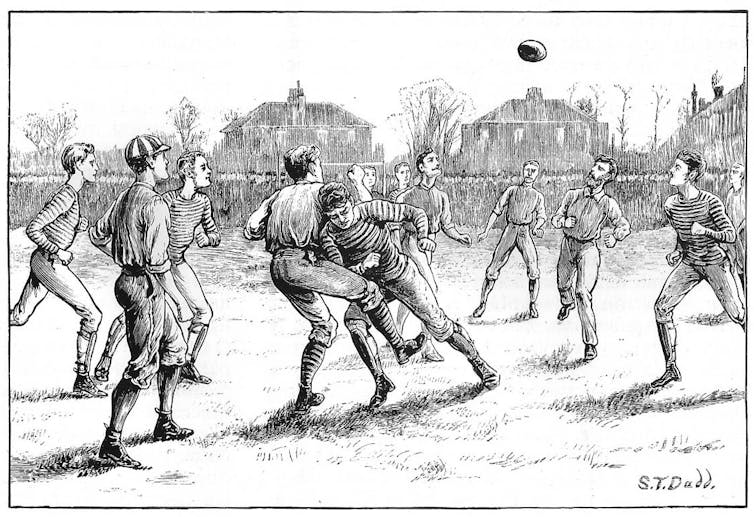In France’s first match of the 2020 European Championship, the team beat Germany 1-0. The team won thanks to an own goal from Germany’s Mats Hummels. However, it could have been 3-0 if two goals, one by Kylian Mbappé and the other Karim Benzema, hadn’t been disallowed. England’s Jordan Henderson similarly had a goal disallowed after being ruled offside in the group stage match against the Czech Republic.
These outcomes were due to tight, but correct, offside decisions. The current rule is that a player is broadly deemed offside if there are fewer than two defending players between the attacker and the goal line when the ball is played forward.
The French goals were penalised due to infringing the offside law by minute margins. So while both goals were offside, it could be argued that because the infractions were so small neither Benzema nor Mbappé were gaining an obvious advantage. Generally, attacking play in football is cherished and encouraged; the strikers might have been technically in breach of the law but not its spirit.
This debate about what is considered good for the game versus the strict and literal application of its laws, specifically offside, is not simply over a minor clause in how the game is officiated. It gets to the heart of a philosophical divide about the game that has been raging for centuries as the rule has been adapted and changed since the game’s inception.
Rugby relic
The first widely agreed offside law was cemented with the formation of the Football Association (FA) and the publication of its laws in 1863. The rule prohibited any attacking player from being in front of the ball when it was kicked forward.
The need for an offside law was partly because the sport then resembled forms of rugby, with similar tactics and players allowed to use their hands to control the ball in some circumstances. “Offside” means unfair. The attacking players are assumed to be gaining an undue advantage by being ahead of the ball when it is played forward. Offside is still intrinsic in modern rugby union and its retention as a principle in football was keenly advocated when the FA was drawing up its 1863 laws.
The intention was to stop “goal hanging” – attacking players occupying positions close to the opponents’ goal and merely waiting for a ball to be played forward to score. The prevalent tactics of the English upper-class teams of the time were instead to assemble up to eight forwards attacking en masse, by dribbling the ball or “scrimmaging” – a euphemism for rudimentary charging, pushing and worse, simply to gain forward progress up the field.

English upper-class football teams did not pass the ball. Their ethos saw the sport as a test of individual strength rather than technical collective endeavour. The game was to be won via English exceptionalism, not socialistic notions of common enterprise.
Not all teams played like this, however. Some 19th-century teams based in English northern industrial communities supported offside, for example, yet played a passing game. In Scotland especially, passing was a key feature of play, though there was no offside rule. Such differences contributed to the evolution of football’s offside law.
Offside evolution
The first changes came in 1866 with a player ruled as “onside” if there were three opponents between him and the goal, or if he was behind the ball when it was played. The impetus was to try to resolve the tension between “fairness” and the need for more goals to be scored.
Subsequent revisions pivoted on this dynamic. In 1873 the rule was changed so that a player was offside when the ball was played forward, rather than when he received the ball. In 1903 came “interfering with play”, a long-standing and often subjective definition of what constitutes a player being active during a period of play in which an offside occurs.
Then in 1925, only two defending players needed to be in advance of the forward for him to be onside. This latter change came about because teams had become so adept at catching opponents offside that games had too often descended into dull, scoreless stalemates.
Modern changes arose in the 1990s with an attacker being level with a defender meaning they were onside. In 2005, it was ruled a player is only deemed offside if a part of their body with which they are legally able to play the ball is beyond the penultimate defender, allied to further definitions of what constitutes interfering with play.

There remains the basic question of why offside is needed at all in football. Marco van Basten, in his role as technical director for Fifa from 2016 to 2018, campaigned for its removal. Van Basted noted that fans wanted more exciting football with fewer stoppages and delays. To achieve, this he argued that removing offside will simplify the game and make it more interesting and dynamic.
Van Basten’s critics counter that this would lead to chaos and the chronic goal hanging that spooked the original lawmakers of the 19th century. Van Basten shares the view of others in pointing to field hockey, which dispensed with its offside law in its entirety in 1998. Far from ruining the game, it is widely held that it has invigorated it by rewarding attacking play and making the game more exciting and free-flowing.
Trials have taken place in football without offside with mixed results. The experimental game led to a very high score (9-7) but a match that was not dramatically different in how it was played tactically overall. Van Basten believes the game could eventually adapt and improve as hockey has.
Less radically, former Arsenal manager Arsene Wenger has proposed another amendment where if any part of an attacking player’s body with which they can legally score is onside when the ball is played, then they are not offside. This addresses the controversies caused by the recent use of video assisted referee (VAR), whereby attackers have been penalised by the application of offside based on millimetre-wide infringements, rendering the whole notion of gaining an advantage to farcical and, ironically, unfair decisions.

